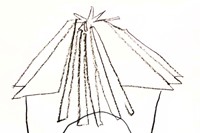We speak to Tomihiro Kono about his creations for the A/W15 Junya Watanabe collection
With undulating fabrics and concertina-like creations, Junya Watanabe's A/W15 collection was a self-proclaimed effort at "exploring dimensionality through clothing." Isamaya Ffrench scrawled mathematical equations onto the arms, legs and necks of the models while Tomihiro Kono created angular foam sculptures to sit atop their heads – it all appeared a wonderfully buoyant inquiry into the technical possibilities within fashion. We spoke to Tomihiro about his inspirations, how he managed to turn his ideas into reality for the show, and what the collaborative process is like with Watanabe.
What is collaborating with Junya Watanabe like?
It’s always very challenging working with Junya – and I mean that in a positive way, because it makes me expand in so many different directions. I always have to come up with a design that suits the clothes, but the amazing thing – and I think the most important part about the way that we work together – is that Junya never shows me the collection. It’s more about a feeling between us, an energy, working in silence. It’s always very special.

What inspired the headpieces? Were there any particular references?
Under the theme of 'Semiotics and Structurism,' I came up with six or seven design propositions for Junya, and made paper prototypes of them. When he chose the one he liked, I then had to think of what material to use. The design that he chose was very big, so I had to think of a light material for stability and, of course, the model. That’s when I came up with the idea of sponge…but it was my first time using sponge as a head-piece material. The design itself was originally inspired by a 3D haircut diagram, the technical drawings that stylists use for cutting hair, that I learned how to draw when I was working in a hair salon.
How did you construct them?
I started to calculate the circumference using the diameter…it was like studying maths back at school. I made a column for the base of the head-pieces and then added some hair-wings in a radial pattern.













